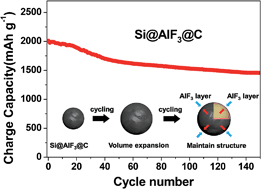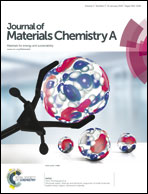Novel design of silicon-based lithium-ion battery anode for highly stable cycling at elevated temperature†
Abstract
Despite Si being one of the most promising anode materials in lithium-ion batteries, significant challenges remain, including a large volume change, low electrical conductivity and high temperature operation for practical use. Herein, we demonstrate a facile synthesis of Si particles with double-shell coating layers, in which aluminum trifluoride (AlF3) acts as an artificial defensive matrix, and carbon layers enhance electrical conductivity and compatibility with carbon black. Our study reveals that Si anodes with double shell layers composed of AlF3 exhibit excellent electrochemical properties at 25 °C and 60 °C, owing to the formation of a stable solid electrolyte interface layer on the Si surface, and the good mechanical strength and chemical nature of AlF3 layers. The Si@AlF3@C anode shows a significantly improved cycling performance (capacity retention of 75.8% after 125 cycles at 25 °C and 73.7% at 60 °C after 150 cycles, compared to the specific capacity in the first cycle) and excellent rate capability of >1600 mA h g−1, even at a 5C rate (at 25 °C). Furthermore, the AlF3 assisted Si electrode exhibits remarkably reduced volume expansion (thickness change of 71% after 125 cycles at 25 °C and 128% after 150 cycles at 60 °C).


 Please wait while we load your content...
Please wait while we load your content...